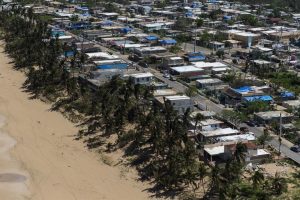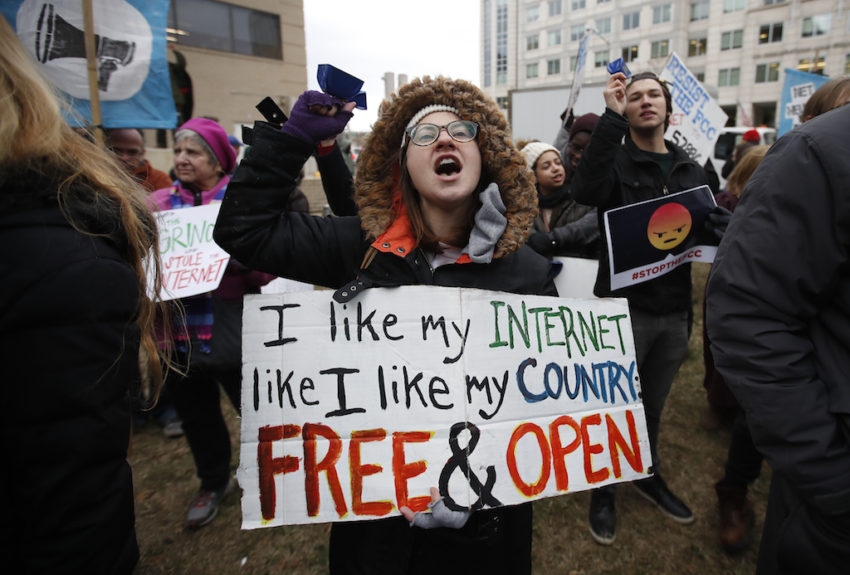Harvey Wasserman Originally published by The Progressive on December 1, 2017
 Blue roofs, temporary blue plastic sheeting, installed on homes damaged by Hurricane Maria, by the U.S. Army Corps of Engineers in partnership with FEMA in Ponce, Puerto Rico.
Blue roofs, temporary blue plastic sheeting, installed on homes damaged by Hurricane Maria, by the U.S. Army Corps of Engineers in partnership with FEMA in Ponce, Puerto Rico.
Warring visions have now erupted over the energy and economic futures of Puerto Rico and the Virgin Islands.
Will the islands become a cutting-edge green-powered solartopia for the benefit of their long-time residents? Or a fossil-fueled robber baron playground like Hong Kong or Singapore, set to operate for the profit of outside corporate investors? On the solartopian side, Senators Elizabeth Warren and Bernie Sanders have proposed a $146 billion green “Marshall Plan” to rebuild Puerto Rico and the Virgin Islands as a prosperous, self-sufficient home for the indigenous citizenry. The bill is co-sponsored by Democratic Senators Ed Markey, Richard Blumenthal and Democratic Representatives Nadia Velazquez and Darren Soto along with Democrat Stacey Plaskett, the Virgin Islands’ non-voting Representative to Congress. Representative Plaskett has also joined Congressman Ted Lieu, Democrat of California, in co-signing a letter asking that all Federal Emergency Management Agency funds for rebuilding the electric grids of the islands go for solar energy, wind power, and decentralized microgrids. San Juan Mayor Carmen Yulin Cruz, who famously tangled with Trump over the direction of recovery plans, has said the Sanders-Warren-Lieu approach to rebuilding with green energy provides the blueprint for the “transformation” of the islands to local-controlled self-sufficiency. The Warren-Sanders bill would give local governments $62 billion for economic development, Medicare/Medicaid parity, and other locally determined needs. It would provide $27 billion more for infrastructure, and $13 billion for FEMA to rebuild the grid “with more modern, resilient technologies” than the coal, oil, and gas burners that powered the islands before Maria. Solar panels are already pouring in. Even before Maria, Puerto Rico had plans to add 1.5 gigawatts of solar capacity. At least one big solar array largely survived the storm, allowing a local greenhouse to resume business the day after the disaster. A large wind farm on the south side of Puerto Rico also got through, though its impact has been limited by the crippled grid. After the storm, in consultation with Puerto Rico’s governor Ricardo Rossello, Elon Musk’s Solar City/Tesla donated a solar array that has successfully re-powered San Juan’s Hospital del Nino, making it one of the few hospitals on the island with a reliable source of electricity. As Musk said in a tweet, “The Tesla team has done this [built solar grids] for many smaller islands around the world, but there is no scalability limit, so it can be done for Puerto Rico too.”
To do more, Tesla announced it would delay the unveiling of its electric-powered tractor-trailer unit to focus on delivering more batteries to Puerto Rico.
The German company Sonnen, which was working pre-Maria with local customers to make the Puerto Rican grid more resilient, has been shipping inpanels, batteries, and micro-grids aimed at making hospitals and emergency facilities self-sufficient. So has the Houston-based Sunnova, which isretaining ownership of the hundreds of panels it has installed, then charging its customers a rate well below what they were paying before the storm hit.
“I am 100 percent backing renewables,” said Governor Rosselló to the U.S. Senate Energy and Natural Resources Committee. “This is an opportunity to make microgrids in Puerto Rico so they can be sustained in different areas.”
But not everyone shares the vision of a green-powered future. In October, Puerto Rico’s national utility, PREPA, made global headlines with a $300 million grid rebuilding contract given to Whitefish Energy, a two-year-old two-man operation based in Whitefish, Montana.
Whitefish is the hometown of Trump Interior Secretary Ryan Zinke, whose son had worked for the company. When it began shipping in line workers at huge rates, they were showered by locals with rocks and bottles. Finally the contract was voided and PREPA’s president resigned.
More recently, PREPA awarded a $200 million contract to Cobra Acquisitions LLC, a one-year-old subsidiary of Oklahoma-based Mammoth, which is primarily in the oil, gas, and fracking business. Nearly all Puerto Rico’s pre-Maria power came from fossil fuels. Its future plans still include a $400 million liquid gas terminal.
The fossil-fueled vision has strong support among lawmakers like Doug Lamborn, Republican of Colorado, who is backed by the oil and gas industry. Lamborn told a House Committee on Natural Resources hearing in early November that “renewables are great, but to provide that much electricity in that short a time is unrealistic.” Lamborn instead supports natural gas, with a rollback of environmental protections to encourage drilling and imports.
Committee Chair Rob Bishop, Republican of Utah, also the recipient of fossil industry support, has joined Lamborn in opposing an EPA presence that might restrict drilling and imports for a restored fossil-fired grid.
But corporate visions for the islands hardly stop with gas and oil. Representative Louie Gohmert, Republican of Texas, thinks “Puerto Rico has the potential of being the Hong Kong of the United States, where businesses would flood in there.”
Benjamin Dierker, of the libertarian Foundation for Economic Education, wants an “economic freedom zone” where environmental, minimum wage and other legal requirements would disappear. The “less restricted environment with more available resources would open the doors to investment and real estate development,” he says.
Desmond Lachman, a resident fellow at the American Enterprise Institute, alsowants a reduced minimum wage and “corporate-friendly economic reforms” to make Puerto Rico “the Singapore of the Caribbean.”
Amid all of this corporate conniving, the people of Puerto Rico remain in dire straits.
“Food and water are still in short supply,” Joel Segal, a North Carolina activist with strong ties to the island, said in a recent radio interview on my Green Power & Wellness show on www.prn.fm. “The FEMA people just hand out forms with a phone number to call and a website to consult. People can’t even get tarps to cover what’s left of their homes.”
At least 200,000 citizens have already left Puerto Rico, most headed for Florida.
Residents who have been restoring school buildings and re-starting classes at their own expense are being told by local authorities they must have inspections that never happen and permits that never come. Education activists are afraid that private charter schools will crush the public system, as in New Orleans after Katrina, where only a few public schools remain.
Because land titles have been passed down through generations of the poor, some ancestral residents are not being let back into what’s left of their homes because they can’t officially prove ownership.
“Land prices will plummet,” Segal says. “That will set off an unrestricted corporate rampage” aimed at converting the region to a Trump-style playground of shady financial centers, high-end hotels and mega-casinos for the super-rich.
That’s a future the people of Puerto Rico must avoid — and green energy is one way to do it.
Harvey Wasserman hosts California Solartopia at KPFK-Pacifica, 90.7FM in Los Angeles, and the Green Power & Wellness podcast at prn.fm. He is author or co-author of about 20 books, including Solartopia! Our Green-Powered Earthat www.solartopia.org.
Follow Harvey Wasserman on Twitter @Solartopia


 The announcement by US Attorney-General Jeff Sessions that he’ll pursue federal pot prosecutions has two age-old motivations: power and money.
Financially, of course, the Republican party is vested in America’s vast private prison system. Every new arrestee means money in the pockets of the investors who own and operate them. Keeping those cells and beds occupied is the essence of the industry”and of Pot Prohibition.
The Drug War is a giant cash cow, not only for the prison owners, but for the cops, guards, lawyers, judges, bailiffs and all the other operatives whose livelihood depends on destroying those of the nation’s tens of millions cannabis customers.
Medical legalization in about half the country, and full legalization in California, Colorado and other states, represents a serious threat to this multi-billion-dollar incarceration scam. Sessions has risen to its defense.
Then there’s the power.
As long as so many millions of people smoke the stuff, marijuana’s illegality give police the ability to bust whoever they want, whenever they want. It is the core enabler of a police state.
In fact, Pot Prohibition is a major foundation of the Republican Regime stretching from the White House and Congress to state government, the courts and beyond.
The key is disenfranchisement.
Since the Drug War’s initiation by Harry J. Anslinger in the 1930s, the principle focus has been on people of color. Anslinger promoted the term “marijuana” to deal with cannabis because it has an Hispanic twinge and aroused paranoid bigotry among the white population.
While promoting films like “Reefer Madness” to make pot appear like some sinister force, Anslinger’s minions made cannabis into a racist menace.
But it was Richard Nixon who took the assault to its ultimate depth. Nixon hated blacks and hippies. He also had a serious interest in slashing into their communities, and depriving them of the vote.
In 1972 his own Blue Ribbon Schaefer Commission recommended against Prohibition. Chaired by Pennsylvania’s liberal Governor Richard Schaefer, it said the health impacts did not warrant a national campaign.
Nixon ignored all that. Amidst a terrible war and racial upheavals, he proclaimed Drugs to be America’s most serious problem.
His own staff knew better. As aide John Ehrlichmann put it:
“The Nixon campaign in 1968, and the Nixon White House after that, had two enemies: the antiwar left and black people.
“You understand what I’m saying? We knew we couldn’t make it illegal to be either against the war or black, but by getting the public to associate the hippies with marijuana and blacks with heroin. And then criminalizing both heavily, we could disrupt those communities,” Ehrlichman said. “We could arrest their leaders. raid their homes, break up their meetings, and vilify them night after night on the evening news.
The announcement by US Attorney-General Jeff Sessions that he’ll pursue federal pot prosecutions has two age-old motivations: power and money.
Financially, of course, the Republican party is vested in America’s vast private prison system. Every new arrestee means money in the pockets of the investors who own and operate them. Keeping those cells and beds occupied is the essence of the industry”and of Pot Prohibition.
The Drug War is a giant cash cow, not only for the prison owners, but for the cops, guards, lawyers, judges, bailiffs and all the other operatives whose livelihood depends on destroying those of the nation’s tens of millions cannabis customers.
Medical legalization in about half the country, and full legalization in California, Colorado and other states, represents a serious threat to this multi-billion-dollar incarceration scam. Sessions has risen to its defense.
Then there’s the power.
As long as so many millions of people smoke the stuff, marijuana’s illegality give police the ability to bust whoever they want, whenever they want. It is the core enabler of a police state.
In fact, Pot Prohibition is a major foundation of the Republican Regime stretching from the White House and Congress to state government, the courts and beyond.
The key is disenfranchisement.
Since the Drug War’s initiation by Harry J. Anslinger in the 1930s, the principle focus has been on people of color. Anslinger promoted the term “marijuana” to deal with cannabis because it has an Hispanic twinge and aroused paranoid bigotry among the white population.
While promoting films like “Reefer Madness” to make pot appear like some sinister force, Anslinger’s minions made cannabis into a racist menace.
But it was Richard Nixon who took the assault to its ultimate depth. Nixon hated blacks and hippies. He also had a serious interest in slashing into their communities, and depriving them of the vote.
In 1972 his own Blue Ribbon Schaefer Commission recommended against Prohibition. Chaired by Pennsylvania’s liberal Governor Richard Schaefer, it said the health impacts did not warrant a national campaign.
Nixon ignored all that. Amidst a terrible war and racial upheavals, he proclaimed Drugs to be America’s most serious problem.
His own staff knew better. As aide John Ehrlichmann put it:
“The Nixon campaign in 1968, and the Nixon White House after that, had two enemies: the antiwar left and black people.
“You understand what I’m saying? We knew we couldn’t make it illegal to be either against the war or black, but by getting the public to associate the hippies with marijuana and blacks with heroin. And then criminalizing both heavily, we could disrupt those communities,” Ehrlichman said. “We could arrest their leaders. raid their homes, break up their meetings, and vilify them night after night on the evening news.  He is author or co-author of about 20 books, including Solartopia! Our Green-Powered Earth at
He is author or co-author of about 20 books, including Solartopia! Our Green-Powered Earth at Enough is enough. Especially when it comes to a name.
Many of you have undoubtedly faced a crisis or two about your own. It can come from anywhere, like changing (or NOT) your family name when getting married. Or dumping the curse of one you never liked.
Famous examples abound. The great Texas-born classical pianist Van Cliburn was in fact Harvey Lavan Cliburn. Lady Gaga is Stefani Joanne Angelina Germanotta. Kirk Douglas was Issur Danielovitch. Marilyn Monroe came from Norma Jean Mortenson. Tony Curtis had been Bernard Schwartz. John Wayne was Marion Mitchell Morrison.
You get the picture.
When I was born in Boston 72 years ago this New Year’s Eve, my mom made my father promise not to name me “Harvey.” Dad’s father, who’d just passed away, was Herschel. So the “H” was unavoidable. But there were certainly better choices. She never forgave him. Me either.
My middle name is Franklin, as my parents were big FDR fans. As an historian, I like it for Ben.
But “Harvey”?
The rabbit in the Jimmy Stewart movie was in fact a real-life “Pooka”, a Celtic spirit.
But in light of recent history, now that I’ve moved to Los Angeles, being introduced to new friends comes with “NOT the Hurricane, NOT Weinstein, NO relation to Debbie Schultz.”
Enough!
So I am shedding my slave name. Instead, where viable, we go with my hippie logo: Sluggo.
That silly moniker originated with a friend who thought I looked like a comic strip character, now long gone from the funny pages. Like me, that Sluggo had a sister Nancy. For more than a decade I lived with it on my communal farm, amidst friends and lovers who never knew my “real” identity.
That silly moniker originated with a friend who thought I looked like a comic strip character, now long gone from the funny pages. Like me, that Sluggo had a sister Nancy. For more than a decade I lived with it on my communal farm, amidst friends and lovers who never knew my “real” identity.
The name’s best feature is that little kids love it. It always morphs into “Swuggo”, prompting an instant smile.
It’s also a decent WTF radio name, quick to say, puzzling, memorable, at home in Solartopia on KPFK and PRN.
Enough is enough. Especially when it comes to a name.
Many of you have undoubtedly faced a crisis or two about your own. It can come from anywhere, like changing (or NOT) your family name when getting married. Or dumping the curse of one you never liked.
Famous examples abound. The great Texas-born classical pianist Van Cliburn was in fact Harvey Lavan Cliburn. Lady Gaga is Stefani Joanne Angelina Germanotta. Kirk Douglas was Issur Danielovitch. Marilyn Monroe came from Norma Jean Mortenson. Tony Curtis had been Bernard Schwartz. John Wayne was Marion Mitchell Morrison.
You get the picture.
When I was born in Boston 72 years ago this New Year’s Eve, my mom made my father promise not to name me “Harvey.” Dad’s father, who’d just passed away, was Herschel. So the “H” was unavoidable. But there were certainly better choices. She never forgave him. Me either.
My middle name is Franklin, as my parents were big FDR fans. As an historian, I like it for Ben.
But “Harvey”?
The rabbit in the Jimmy Stewart movie was in fact a real-life “Pooka”, a Celtic spirit.
But in light of recent history, now that I’ve moved to Los Angeles, being introduced to new friends comes with “NOT the Hurricane, NOT Weinstein, NO relation to Debbie Schultz.”
Enough!
So I am shedding my slave name. Instead, where viable, we go with my hippie logo: Sluggo.
That silly moniker originated with a friend who thought I looked like a comic strip character, now long gone from the funny pages. Like me, that Sluggo had a sister Nancy. For more than a decade I lived with it on my communal farm, amidst friends and lovers who never knew my “real” identity.
That silly moniker originated with a friend who thought I looked like a comic strip character, now long gone from the funny pages. Like me, that Sluggo had a sister Nancy. For more than a decade I lived with it on my communal farm, amidst friends and lovers who never knew my “real” identity.
The name’s best feature is that little kids love it. It always morphs into “Swuggo”, prompting an instant smile.
It’s also a decent WTF radio name, quick to say, puzzling, memorable, at home in Solartopia on KPFK and PRN.
 Harvey “Sluggo” Wasserman has many grandchildren who call him “Boppa” and/or “Harby.” “Swuggo” will now be added to the mix.
Follow Harvey on Twitter
Harvey “Sluggo” Wasserman has many grandchildren who call him “Boppa” and/or “Harby.” “Swuggo” will now be added to the mix.
Follow Harvey on Twitter 
 While the whole world watches Tuesday’s Alabama US Senate election, race-based battles behind the scenes could decide the outcome.
They focus on likely
While the whole world watches Tuesday’s Alabama US Senate election, race-based battles behind the scenes could decide the outcome.
They focus on likely  Blue roofs, temporary blue plastic sheeting, installed on homes damaged by Hurricane Maria, by the U.S. Army Corps of Engineers in partnership with FEMA in Ponce, Puerto Rico.
Blue roofs, temporary blue plastic sheeting, installed on homes damaged by Hurricane Maria, by the U.S. Army Corps of Engineers in partnership with FEMA in Ponce, Puerto Rico.
Hollywood Stars, Grassroots Activists, State Senator, Mayor & Major Organizations Ask Gov. Newsom to Fully Inspect Aged Diablo Canyon Nuclear Unit One Before it Re-Fuels
Hollywood Stars, Grassroots Activists, State Senator, Mayor & Major Organizations
Ask Gov. Newsom to Fully Inspect Aged Diablo Canyon Nuclear Unit One Before it Re-Fuels
Contact: Mimi Kennedy (315) 246-7333; Harvey Wasserman (614) 738-3646 – solartopia@gmail.com; Myla Reson (310) 663-7660 – myla.reson@gmail.com
Dear Gov. Newsom,
We join hundreds of other Californians, including Sen. Ben Allen and San Luis Obispo Mayor Heidi Harmon, who are calling, writing, faxing and e-mailing, asking that you take action at Diablo Canyon to protect our safety and economic future. Under PG&E’s current bankruptcy and criminal proceedings, your position gives you wide ranging powers to act.
Diablo Unit One is now shut for refueling. We feel that given the evidence of embrittlement, it is very important to halt the loading of new fuel into the reactor until the public resolution of seven critical issues:
We ask that BEFORE DIABLO ONE REFUELS you subject these and other critical issues to open public scrutiny. The decision on Diablo’s future must be made by you in conjunction with the Legislature, the CPUC, state agencies, the courts and the public.
We thank you very much for giving this your serious consideration. We feel this is an exciting and crucial opportunity for you to continue your groundbreaking leadership in bringing more safety, responsibility, and wise energy policy to all Californians. Let us keep showing the way to a safer (and more sustainable) energy future.
– – – –
Signatories (partial list):
Mimi Kennedy
Jane Fonda
Jodie Evans, CODEPINK
Frances Fisher
Lila Garrett
Dr. Helen Caldicott
Dianna Cohen, CEO & Co-Founder, Plastic Pollution Coalition
Susan Clark
Barbara Williams
Ed Asner
Graham Nash
Eric Roberts
Martin & Janet Sheen
Keaton & Eliza Simon
Ed Begley, Jr.
Lance Simmens
John Densmore, Drummer for the Doors
Dana Gluckstein, Chair People for A Safe Future
David Krieger, President Nuclear Age Peace Foundation (NAPF)
Sara Nichols
Nancy Stevens
Alan Weissman
Pamela Conley Ulich, former Malibu Mayor
Roger Pugliese
Tony Dow
David Braun
Dr. Peter Alsop
Alan Minsky, PDA
– – –
Separate petitions, resolutions & other supporting letters & documents are from:
Topanga Town Council
San Luis Obispo Mothers for Peace
Americans for Democratic Action (Los Angeles)
Progressive Democrats of the Santa Monica Mountains
Pacific Palisades Democratic Club
Santa Monica Democratic Club Executive Board
The Officers of the Progressive Caucus of the California Democratic Party
The Los Angeles County Democratic Party
Culver City Democratic Club
People Demanding Action Campaign:
Reach: 60,000
1,725 Letters Sent
85 phone calls
Facebook Ad Campaign:
Reach: 108,000
Impressions: 115,680
Video Views: 56,101
Join Us at MoveOn.org: 4,372; signees: 1,017
Twitter campaign: #TestDiablo
Diablo Canyon Nuclear Power Plant